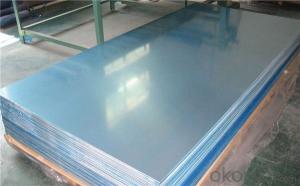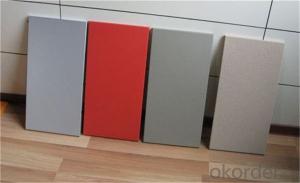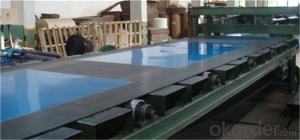Aluminium Sheet China High Quality Roofing Pe Pvd Colour Coated
- Loading Port:
- Shanghai
- Payment Terms:
- TT OR LC
- Min Order Qty:
- 5 m.t.
- Supply Capability:
- 100000 m.t./month
OKorder Service Pledge
OKorder Financial Service
You Might Also Like
Item specifice
Packaging & Delivery
Packaging Details: | Standard export packing or following customer's demand |
Delivery Detail: | Within 20-25days or according to the order quantity |
High Quality and Factory Price Aluminum Coil
Specifications
Grade
| 1000 Series: 1050 1060 1070 1100 1200 1235 etc. 3000 Series: 3003 3004 3005 3104 3105 3A21 etc. 5000 Series: 5005 5052 5083 5086 5154 5182 5251 5754 etc. 6000 Series: 6061 6063 6082 6A02 etc. 8000 Series: 8006 8011 8079 etc. |
Thickness | 0.05~10mm |
Width | <1600mm< span=""> |
Color | Metallic, Solid, RAL or by customer requirements |
Coating paint: | PVDF(Polyvinylidene Fluoride), PE(Polyester ) |
Coating thickness | as per customer’s request |
Gloss | 10-90%(EN ISO-2813:1994) |
Total coating thick | Polyester18~27micron(EN ISO-2360:1995) PVDF27 ~35micron(EN ISO-2360:1995) |
Coating hardness | 2H |
Protective film | PVC film, Colorless transparent or White-black |
Adhesion | 5B (EN ISO-2409:1994) |
Impact resistance | No cracking and peeling (A.S.T.M D2794-1993) |
Flexibility (T-bend) | 0T- 2T |
Temper | H16, H18, H24, H26, H26 |
Certification | ISO9001:2000, CE, SGS |
Coil's standard diameter | 1100mm |
Inner Diameter | 405mm/505mm |
Coil's standard weight | 2000kgs |
Payment | L/C ,T/T |
Parameter
Product | Alloy | Temper | Thickness | Width | I.D(mm) | Application |
Aluminum Coil/Strip | 1050,1060,1070, 1100,1200,1235, 1145,3003,304, 3105,3A21, 8011 | O H12 H14 H16 H18 H22 H24 H26 | 0.2-8mm | 50-2400mm | 75,150 200,300 400,505 (as customers's request) | construction,decoration, automobile,electronic, machinery,boat construction, aeronatics&astronautics, cookware,packing etc. |
Application:
1) Radiator
2) Condenser
3) Insulation Material
4) Construction
5) Decoration
6) Advertisement and market applications
Photos
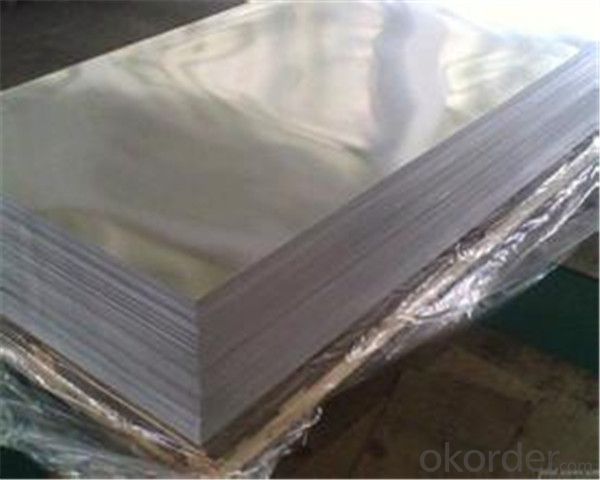
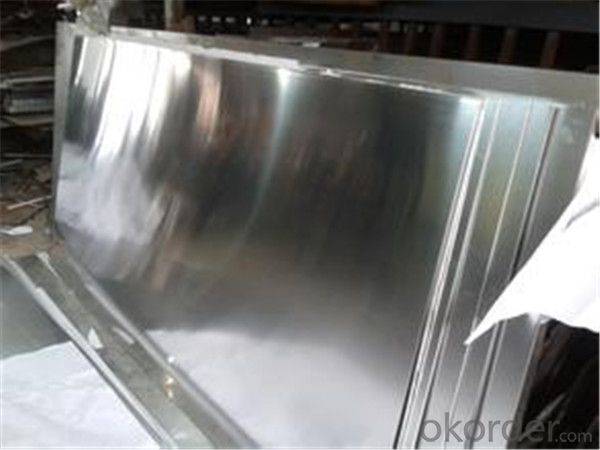

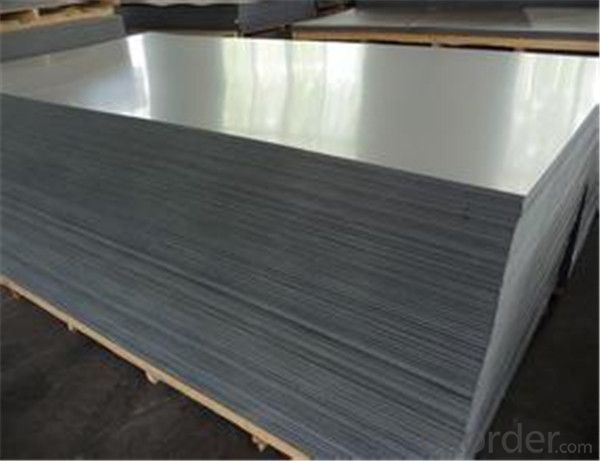
- Q:How do aluminum plates open holes?
- The opening of the aluminum plate is a relatively simple process,You can do that with a micro electric device like an electric drill or a grooving machine
- Q:How does the formability of aluminum sheet vary with different alloys?
- The formability of aluminum sheet can vary significantly with different alloys. Some aluminum alloys have excellent formability, allowing for easy bending, shaping, and forming without cracking or tearing. These alloys are commonly used in applications that require complex shapes or intricate designs. On the other hand, certain aluminum alloys may have lower formability, making them more difficult to shape without the risk of deformation or failure. The choice of alloy will depend on the specific requirements of the application and the desired level of formability needed.
- Q:What are the environmental benefits of using aluminum sheets?
- The usage of aluminum sheets is associated with numerous environmental advantages. To begin with, aluminum is a highly recyclable substance, meaning it can be recycled repeatedly without losing its quality or properties. This diminishes the need for mining and extracting new aluminum ore, which can lead to deforestation, destruction of habitats, and pollution of water and air. The recycling of aluminum sheets also demands much less energy compared to the production of new ones, resulting in reduced emissions of greenhouse gases and a smaller carbon footprint. Moreover, aluminum sheets are lightweight, making them a more sustainable option in comparison to materials like steel or plastic. Their utilization in various industries like automotive and aerospace can aid in reducing the overall weight of vehicles and aircraft, leading to improved fuel efficiency and lower emissions. This becomes particularly crucial in the context of climate change and the necessity to decrease our reliance on fossil fuels. Additionally, aluminum is resistant to corrosion, durable, and long-lasting, making it a sustainable choice for various applications. Its durability lessens the need for frequent replacements, thereby reducing waste generation. Furthermore, aluminum sheets can be employed in construction to enhance insulation, resulting in energy savings and diminished emissions of greenhouse gases. Lastly, aluminum is non-toxic and does not release harmful pollutants during its production or use. This renders it a safe material option for various applications, including food packaging and medical equipment. To summarize, the environmental benefits of using aluminum sheets include its recyclability, lightweight nature, energy efficiency, durability, and non-toxicity. By selecting aluminum sheets over other materials, we can contribute to the reduction of resource extraction, energy consumption, emissions of greenhouse gases, and generation of waste, while promoting a more sustainable and eco-friendly future.
- Q:Is the value of specific heat capacity of aluminium higher or lower than the standard value? Why?
- This is not my expertise. As I have been researching this the past hour to re-educate myself, no one else has answered you. So, I will attempt to get you in the right direction by what I found. I found two specific heat values for Aluminum. The recent one is from wikipedia with the other an old text someone quoted. The specific heat of aluminum, cAl, is 0.897J g?1 K?1; this is, 0.214cal g?1 °C?1. [per wikipedia] AND The specific heat capacity of aluminum as 0.215 kcal/(kg C) [The Handbook of Chemistry and Physics, p. D-217, 1979]. Standard Value was the harder item. I found it is referred to as Hro [Where the o is a circle]. I could only find it referring to water. To measure heat for each metal, it was always compared to the heating water, which is used as the standard. I'm guessing its like a thermometer filled with mercury. The mercury gets heated and the lines are marked to tell you how hot the air is. Hope that helps... Maybe someone else will jump in...
- Q:Aluminum and oxygen gas react to produce aluminum oxide
- Aluminium oxide is Al2O3, so there are 3 oxygen atoms for every 2 aluminium atoms. Divide 75 by the relative atomic mass of oxygen (15.9994). That is proportional to the number of oxygen atoms. Then divide by 3 and multiply by 2. This gives a number proportional to the number of aluminium atoms. Then multiply this by the relative atomic mass of aluminium (26.981529) to give the mass of aluminium required in grams.
- Q:I'm gonna drop the dime and get a bass boat. other than weight why is a fiberglass better than aluminum?I'm looking at the difference between the top of the line BassTracker and the bottom of the line Nitro. I only want about a 90 -115 hp and I'm gonna buy a couple years old to save some money.. so what are the pros - cons?
- Bass Tracker Aluminum Boats
- Q:Can aluminum sheet be used for chemical processing?
- Aluminum sheet is indeed applicable for chemical processing. Its versatility and resistance to corrosion make it a sought-after material in various industries, including chemical processing. The remarkable attribute of aluminum is its ability to withstand numerous chemicals, such as acids, alkalis, and salts. Therefore, it is well-suited for situations where exposure to corrosive substances is prevalent. Moreover, aluminum possesses the advantages of being lightweight, long-lasting, and possessing excellent thermal conductivity. These qualities make it a prime choice for facilitating heat transfer and promoting energy-efficient procedures in chemical industries. However, it is crucial to assess the specific chemical environment and seek guidance from experts to guarantee the compatibility of aluminum with the particular chemicals and conditions involved in the process.
- Q:Can the aluminum sheets be used for manufacturing kitchen countertops?
- Yes, aluminum sheets can be used for manufacturing kitchen countertops.
- Q:How do aluminum sheets perform in terms of weldability?
- Aluminum sheets generally have good weldability due to their low melting point and excellent thermal conductivity. Welding aluminum sheets is relatively easy and can be done using various techniques such as TIG (tungsten inert gas) welding, MIG (metal inert gas) welding, or even spot welding. However, there are a few factors that can affect the weldability of aluminum sheets. Firstly, the surface of the aluminum sheet needs to be clean and free from any contaminants such as oil, grease, or oxide layers. These contaminants can negatively impact the quality of the weld. Therefore, proper cleaning and preparation of the surfaces to be welded is crucial. Secondly, aluminum sheets have a high thermal conductivity, which means that heat dissipates quickly. This can make it challenging to control the temperature during the welding process. It is essential to have a skilled and experienced welder who can adjust the welding parameters accordingly to ensure a successful weld. Lastly, aluminum sheets have a high coefficient of thermal expansion, which can lead to distortion or warping during welding. To minimize these issues, techniques such as tack welding or clamping may be employed to hold the sheets in position. In summary, aluminum sheets generally exhibit good weldability due to their low melting point and excellent thermal conductivity. However, proper surface preparation, skilled welding techniques, and careful temperature control are essential to achieve high-quality welds and avoid potential issues like contamination, distortion, or warping.
- Q:Can aluminum sheets be used for electrical applications?
- Indeed, aluminum sheets find utility in electrical applications. Renowned for its exceptional conductivity, aluminum boasts nearly 60% of copper's electrical conductivity. This renders it suitable for diverse electrical applications, ranging from wiring and bus bars to transformers and electrical panels. Owing to their lightweight and resistance to corrosion, aluminum sheets are frequently employed in the fabrication of electrical enclosures and housings. Furthermore, aluminum emerges as a cost-effective alternative to other metals, such as copper, thereby solidifying its reputation as a favored selection in numerous electrical applications.
1. Manufacturer Overview |
|
|---|---|
| Location | |
| Year Established | |
| Annual Output Value | |
| Main Markets | |
| Company Certifications | |
2. Manufacturer Certificates |
|
|---|---|
| a) Certification Name | |
| Range | |
| Reference | |
| Validity Period | |
3. Manufacturer Capability |
|
|---|---|
| a)Trade Capacity | |
| Nearest Port | |
| Export Percentage | |
| No.of Employees in Trade Department | |
| Language Spoken: | |
| b)Factory Information | |
| Factory Size: | |
| No. of Production Lines | |
| Contract Manufacturing | |
| Product Price Range | |
Send your message to us
Aluminium Sheet China High Quality Roofing Pe Pvd Colour Coated
- Loading Port:
- Shanghai
- Payment Terms:
- TT OR LC
- Min Order Qty:
- 5 m.t.
- Supply Capability:
- 100000 m.t./month
OKorder Service Pledge
OKorder Financial Service
Similar products
New products
Hot products
Related keywords
